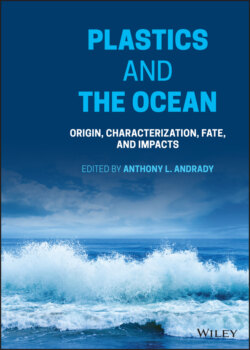Читать книгу Plastics and the Ocean - Группа авторов - Страница 27
1.6.1 Crystallinity in Plastics
ОглавлениеPolymer chains are not only attracted to each other by Van der Waals forces but are also copiously entangled with each other (as in a serving of cooked spaghetti). It is difficult to pull out a single strand from the mass of entangled chains and that contributes to the strength of the polymer. This is particularly true at low temperatures where chains are less flexible.
When the mass of plastic is heated, however, the energy gained by the chain molecules makes them flexible enough for partial mobility and the material becomes softer and pliable. The molecular structure of plastics such as PE is more complicated than illustrated by this simple homogeneous model. In these polymers, short sections of several neighboring long molecular chains, rather than being randomly oriented as elsewhere in the mass, show a regular arrangement somewhat resembling the ordering of molecules in a crystal. These domains are therefore called “crystalline domains” as opposed to the “amorphous” regions of the bulk polymer where the chain molecules are randomly arranged (see illustration in Figure 1.12). Plastics that show crystalline domains in their structure are “semi‐crystalline” plastics. With these plastics, one can assess a fraction of the mass as being crystalline; for instance, a given HDPE sample may be 80% crystalline. Though these are not true crystals, they still melt or undergo a phase transition on heating but only to reform on cooling. Individual crystallites of PE have dimensions in the tens of nm, but their agglomerates in crystalline domains are large enough to be seen by light microscopy. Because of the higher packing densities of chains, the density ρ(g/cm3) of crystalline regions is higher than that of amorphous regions in the polymer. That of the bulk plastic, therefore, depends on its percent crystallinity F(%). In PE, for example, crystalline and amorphous regions have densities, ρ C = 1.004 and ρ A = 0.853 g/cm3, respectively.
Figure 1.11 A schematic of the molecular weight distribution of two samples of polyethylene.
Values of F (%) can be experimentally determined for a given plastic sample using either pycnometry, differential scanning calorimetry (DSC), or X‐ray diffraction methods (Kong et al. 2002; Seidlitz et al. 2016), allowing the average density to be calculated. But, the crystallinity F of a plastic is not an inherent property and thermal treatment or mechanical stress can often increase crystallinity while crosslinking or the presence of solvents can decrease its value. But, the maximum crystallinity achievable by a plastic still depends on its structure, with the highest levels reached in textile fibers as a result of the high levels of the orientation of molecules obtained in spinning and drawing.
Most of the thermoplastic debris commonly found in the marine environment are semi‐crystalline plastics. There are exceptions; for instance, PS and expanded foam as well as PVC debris found in bottom sediment are nearly 100% amorphous. Percentage crystallinity, in turn, determines density, sorption capacity and permeability of the plastic. The solubility of organic pollutants picked up from seawater, as well as oxygen essential for abiotic degradation (that are generally oxidative reactions) are reduced as the fractional crystallinity increases.
The chemical structures of common plastics encountered in marine debris are summarized in Table 1.5. The density of the plastic determines if the debris will float in seawater and therefore degrade to some extent by exposure to sunlight, the main mode of degradation of plastics in the marine environment (see Chapter 10.) However, the densities of the base resins can easily change when additives, especially fillers, are used in high volume fractions, are compounded into plastic products. Also, products such as foams of PS or bottles of PET may float because of entrapped air, even though the density of the plastic is greater than that of seawater.
Table 1.5 Common plastics litter found in the marine environment.
| Polymer | Symbol | Structure | Density ρ (g/cm 3 ) | Tg (°C)a |
|---|---|---|---|---|
| Polyethylene | PE | ‐125 | ||
| ‐Low‐density PE | LDPE | Chain structure with long branches | 0.89–0.93 85–125 | |
| ‐High density PE | HDPE | Chain structure with minimal branches | 0.94–0.98 130–140 | |
| Polypropylene | PP | 0.83–0.92 | ‐20 to ‐5 | |
| Polystyrene | PS | 1.04–1.1 0.05 (Foam)b | 90–100 | |
| Poly(vinyl chloride) | PVC | 1.16–1.58 | 87 | |
| Poly(ethylene terephthalate) | PET | 1.37–1.45 | 67–80 | |
| Polyurethane | PU | 1.2 0.05–0.96 (Foam)b | ‐20 | |
| Polyamide (Nylon 66) | PA | 1.31 | 50–60 | |
| Cellulose acetate | CA | D.S ~ 2.45c | 1.29–1.31 | ~187 |
a Glass transition temperature
b Density of foamed plastics depends on the fraction of air or other gas in the plastic
c D.S, the degree of substitution for CA used in cigarette filters (a the predominant constituent of marine beach debris), is about 2.45 but CA is available different values of D.S from 0–3.0 for various applications.
